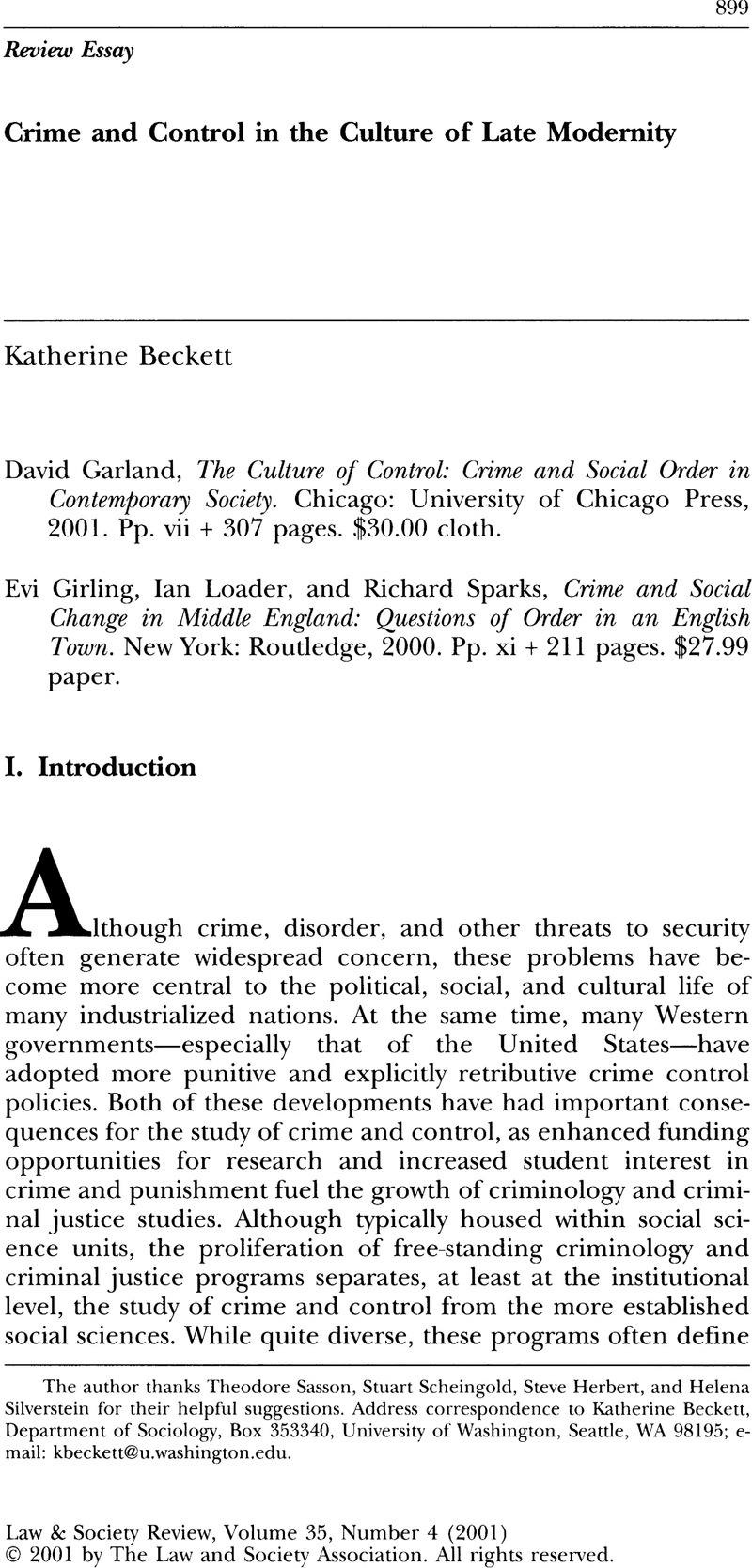Crossref Citations
This article has been cited by the following publications. This list is generated based on data provided by Crossref.
Gottschalk, Marie
2001.
The Prison and the Gallows.
LOADER, IAN
and
SPARKS, RICHARD
2004.
For an historical sociology of crime policy in England and Wales since 1968.
Critical Review of International Social and Political Philosophy,
Vol. 7,
Issue. 2,
p.
5.
GARLAND, DAVID
2004.
Beyond the culture of control.
Critical Review of International Social and Political Philosophy,
Vol. 7,
Issue. 2,
p.
160.
Willis, James J.
2005.
Transportation versus Imprisonment in Eighteenth- and Nineteenth-Century Britain: Penal Power, Liberty, and the State.
Law & Society Review,
Vol. 39,
Issue. 1,
p.
171.
Medina-Ariza, Juanjo
2006.
Politics of crime in Spain, 1978–2004.
Punishment & Society,
Vol. 8,
Issue. 2,
p.
183.
Woods, Joshua
2006.
Searching for the Victim in the General Sociological Literature on Crime.
International Review of Victimology,
Vol. 13,
Issue. 2,
p.
201.
Cullen, Francis T.
Vose, Brenda A.
Lero Jonson, Cheryl N.
and
Unnever, James D.
2007.
Public Support for Early Intervention: Is Child Saving a “Habit of the Heart”?.
Victims & Offenders,
Vol. 2,
Issue. 2,
p.
109.
Saux, María Soledad
2007.
Immigration and Terrorism: A Constructed Connection.
European Journal on Criminal Policy and Research,
Vol. 13,
Issue. 1-2,
p.
57.
Melossi, Dario
2007.
Une criminologie critique modernisatrice ?.
Déviance et Société,
Vol. Vol. 31,
Issue. 4,
p.
405.
LISTWAN, SHELLEY JOHNSON
JONSON, CHERYL LERO
CULLEN, FRANCIS T.
and
LATESSA, EDWARD J.
2008.
CRACKS IN THE PENAL HARM MOVEMENT: EVIDENCE FROM THE FIELD*.
Criminology & Public Policy,
Vol. 7,
Issue. 3,
p.
423.
Sack, Fritz
2008.
Exklusion in der Marktgesellschaft.
p.
301.
Hallett, Michael
2009.
Imagining the global corporate gulag: lessons from history and criminological theory.
Contemporary Justice Review,
Vol. 12,
Issue. 2,
p.
113.
Melossi, Dario
2009.
Book review: Governing through crime, Jonathan Simon. Oxford University Press, 2007. 344 pp. $29.95 (hbk). ISBN 13: 9780195181081.
Punishment & Society,
Vol. 11,
Issue. 1,
p.
137.
Piquero, Alex R.
Cullen, Francis T.
Unnever, James D.
Piquero, Nicole L.
and
Gordon, Jill A.
2010.
Never too late.
Punishment & Society,
Vol. 12,
Issue. 2,
p.
187.
UNNEVER, JAMES D.
and
CULLEN, FRANCIS T.
2010.
THE SOCIAL SOURCES OF AMERICANS' PUNITIVENESS: A TEST OF THREE COMPETING MODELS*.
Criminology,
Vol. 48,
Issue. 1,
p.
99.
Johnson, David T.
2011.
American Capital Punishment in Comparative Perspective.
Law & Social Inquiry,
Vol. 36,
Issue. 04,
p.
1033.
Nuño, Luis F.
2013.
“Police, Public Safety, and Race‐Neutral Discourse”.
Sociology Compass,
Vol. 7,
Issue. 6,
p.
471.
Makin, David A.
2013.
Popular punitivism and cultural mediation: The case of Spain.
International Journal of Law, Crime and Justice,
Vol. 41,
Issue. 3,
p.
260.
Garland, David
2016.
Kriminologische Grundlagentexte.
p.
353.
Seal, Lizzie
2017.
Perceptions of safety, fear and social change in the public’s pro-death penalty discourse in mid twentieth-century Britain.
Crime, Histoire & Sociétés,



